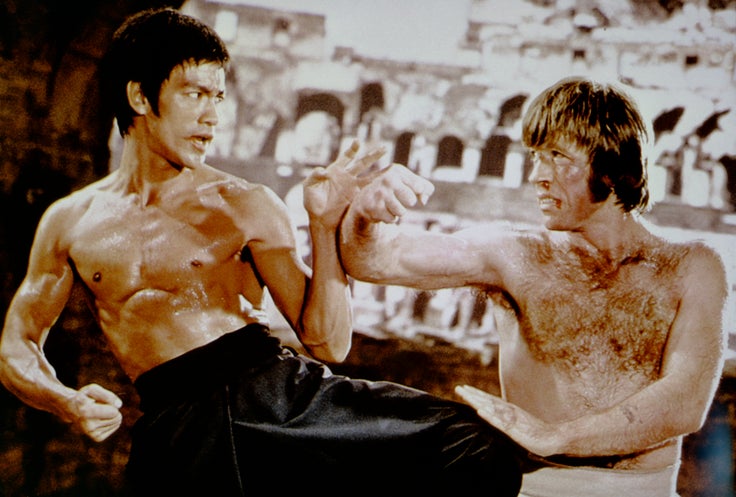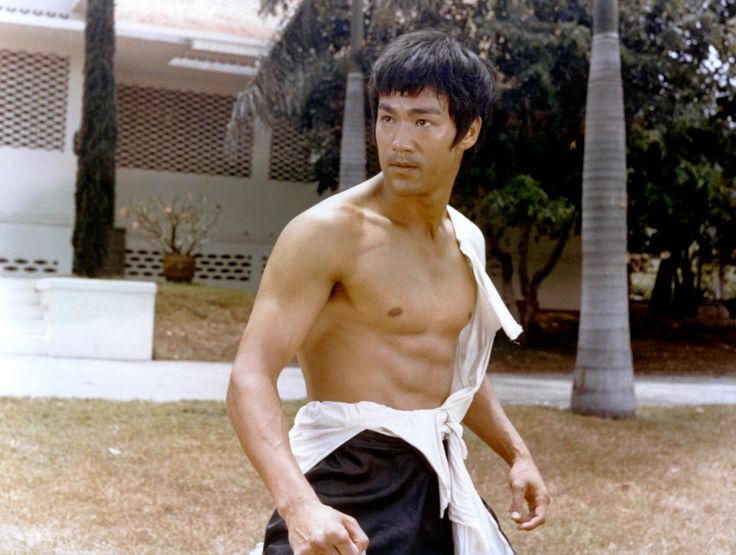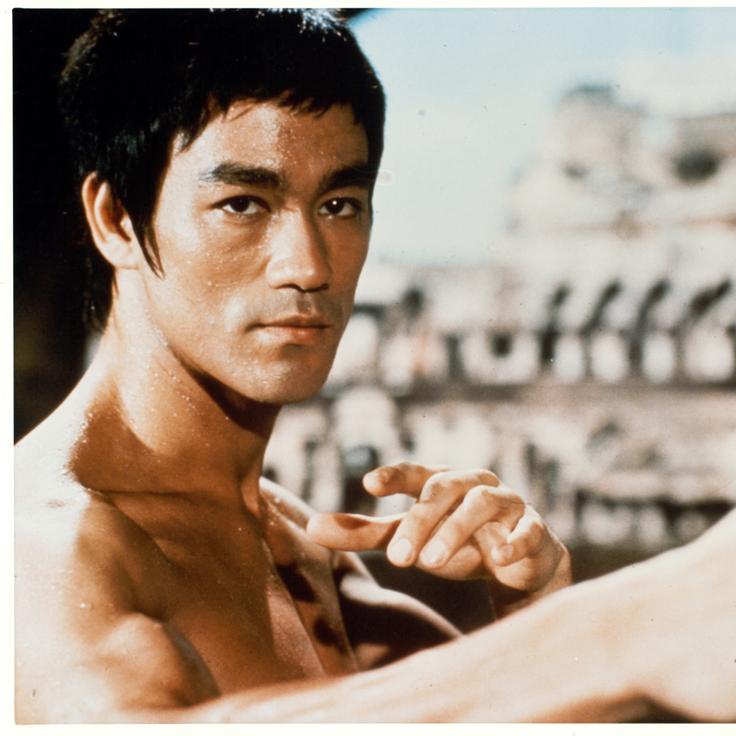Bruce Lee is portrayed only briefly in Quentin Tarantino’s film, “Once Upon a Time in Hollywood.” He’s relegated to a punchline, really ― a surprise, given that Tarantino is an unabashed Lee fan.
But at the showing I saw at a Regal Edwards theater in Alhambra ― a Southern California city with a considerable Asian population ― he might as well have been the star: The second that actor Mike Moh popped up onscreen in his best Lee drag, a good chunk of the theater erupted in claps.
It wasn’t surprising. Forty-six years after Lee’s sudden death at the age of 32 from a cerebral edema, the martial artist maintains a godlike status in the hearts and minds of Asian Americans.
Moh, a martial artist himself, nails Lee’s bravado. As a self-proclaimed Bruce Lee fanboy, the 35-year-old actor and martial artist knew he couldn’t screw it up.
“As a kid growing up in suburban Minnesota, I was one of the only Asian kids, so I was the class clown and a big part of that was me wanting to fit in,” Moh told The Hollywood Reporter recently. “Then I saw Bruce Lee and I was like, ‘Wow, this guy can kick ass, the girls want him, he is super-strong and confident.’ I hadn’t seen someone like that before.”
For Asian American men like Moh who are starved for representation, Lee was the Asian American hero ― the only one. Here, by the grace of the film gods, was a cocksure, ass-kicking, philosophy-spouting action star who actually looked like them.
“My earliest memories of Bruce Lee were the dubbed, pan-and-scan VHS tapes from the ’80s,” said Jeremy Arambulo, an artist whose graphic novel “A Challenge” was inspired by Bruce Lee’s 1964 duel with Wong Jack Man.
“As a child growing up in that era, he seemed as iconic and ubiquitous as Jesus,” the 40-year-old said.
Dan Kwong, a performance artist and writer, had his big Bruce moment in 1972, when he saw “Fist Of Fury” at Chicago’s Biograph Theater. The audience alongside him was mostly white. As he watched the muscular, sprightly Lee run circles around men twice his size, he was filled with a new kind of glee.
“I was in my 20s at the time. Never had there been an Asian man that was as respected and admired by everyone in this country,” Kwong, 64, told HuffPost. “What made Bruce especially impactful was his timing. There simply was no one like him ever before.”
Lee remains the preeminent model of Asian manhood: A few years back, the The Asian American Man Study asked, “Who is the Asian American man you most admire and why?” Bruce Lee was the person the 497 respondents mentioned most often. (Depressingly, the actual most common response was, “I don’t know,” a sad commentary on the invisibility of Asians in film and any other highly public fields.)
“Lee pioneered a model that promised Asian men they could take on any enemy and come out on top,” said Chris Berry, a professor of film studies at King’s College in London.
“In his early films, before he was trying to pander to the wider U.S. audience, there was always a racial hierarchy of opponents, starting with other East Asian men, and ending up with Caucasian men,” he said. “It made his films wildly popular throughout in Third World countries and also with African American audiences.”
Lee was the rare nonwhite leading man and his films leaned into revenge fantasies and sticking up for yourself, much like the Blaxploitation movies of the era.
How Lee Changed Hollywood
Surprisingly, though, the actor only completed five feature films before he died in 1973. But in that short time span, he singlehandedly flipped the script on how we perceive Asian masculinity.
He was fighting against a lot: In films prior to the 1970s, Asian male characters were characterized in two ways: As cultural studies professor Chiung Hwang Chen wrote in a 1996 academic paper, Asians were portrayed as the “threatening masculine ‘yellow peril’” who fought to “kill the white man and take his women.” (That last line is exactly what the title character orders his army to do in 1932’s “The Mask of Fu Manchu.”)
In other movies, they were feminized and emasculated, the professor said. Often, these characters were portrayed by white actors in yellowface. (There were blips of positive representation, but they were few and far between: Brooding Japanese actor Sessue Hayakawa was a silent era heartthrob, and James Shigeta lent his leading man good looks to films in the 1960s.)

Lee refused to be a blip. He took a supporting role in TV’s “Green Hornet,” but movie parts were hard to come by. To make a name for himself, he had to leave Hollywood and work twice as hard. Lee headed to Hong Kong to take on lead roles and make a living. While there, Warner Brothers kept an eye on his career moves, and offered to help him produce “Enter the Dragon,” his last feature film.
In “Enter the Dragon” as with all of his films, it’s impossible to ignore Lee’s physicality. He wasn’t just a lead actor, he was a veritable, shirtless, sweaty sex symbol.
Early film martial artists like Kwan Tak Hing took down enemies fully clothed in flowing robes, but Lee showed off his body, a move that Berry said was likely inspired by the sword-and-sandal flicks of the 1950s starring people like Charlton Heston.
“In theory, martial arts are all about skill and not about physical strength. The body was not important, and it was not displayed,” the film historian said. “With Bruce, the body and its muscles are displayed as weapons. You always know when Bruce is really angry and means business, because that’s when his shirt comes off.”

Off-screen, he favored low V-neck shirts, brightly colored, well-tailored suits and oversized sunglasses. Just like anything else in his life, his wild street style showed he was a man who lived boldly and wanted to stand out.
Lee’s Influential Philosophy About Work Ethic
It wasn’t just Lee’s physical prowess or style that endeared him to fans; his spiritualism and philosophical teachings pack a punch, too.
“For me, it was Bruce’s philosophy that drew me in,” said Osric Chau, a 32-year-old actor and martial artist. “That confidence that magnetizes you and made me consider that maybe I could be that self-assured of myself someday.”
“Be like water,” Lee famously said. Water stays true to its nature, but thoroughly adapts to its environment, much like Lee navigating both the Hollywood and the Hong Kong film industries.
“I fear not the man who has practiced 10,000 kicks once, but I fear the man who has practiced one kick 10,000 times,” he said, a popular quote that speaks to Lee’s utter mastery of his patented style of Jeet Kune Do.
Those words have sticking power. If you were an Asian kid on the playground who was taunted with lazy “Bruce Lee” or “Jackie Chan” name-calling (or worse, hokey “Karate Kid” crane kicks), the physical comparison may have been dicey at best. But the philosophies, you could lean into. Lee reminded you to keep your head high.
He said very pointedly that he had already made up his mind that he was going to show people a real Asian man on-screen. He knew representation was lacking.
Shannon Lee, Bruce Lee's daughter
But even Lee couldn’t shake his otherness in the U.S.: Despite being born in San Francisco, marrying an American woman and holding United States citizenship, The New York Times called Lee “the Chinese actor” in his obituary, which ran at a mere eight lines. Even with his fame, he was still considered the perpetual foreigner.
In life, that emboldened him, Lee’s daughter, Shannon Lee, told HuffPost.
“He said very pointedly that he had already made up his mind that he was going to show people a real Asian man on-screen,” she said. “He knew representation was lacking.”
“Whether he knew how absolutely meaningful it was going to be to so many people or not, I can’t say,” she added. “Unfortunately, he passed before his Hollywood feature made it to the screen.”
Of course, some of the Lee’s mystique comes from having died at just 32; he’s a patron saint of the “live fast, die young, gain a cult following” club.
“Bruce Lee is the Asian Tupac or Biggie, gone before his time,” said Jason Shen, a 33-year-old tech entrepreneur and Asian American advocate. “But while new rappers have emerged like Jay Z and Kanye, all we have is Bruce Lee. Like Peter Pan, he never got old and so he’s young and just present in our lives.”
Asian Masculinity After Bruce Lee
Men like Shen grew up in the ’90s. Asian boys growing up today have considerably more Asian role models. Four decades after Lee’s death, Asian men demand to take up space in every arena, whether they’re running for president, playing romantic leads and Marvel superheroes, or winning NBA championships.
Obviously, our ideas about Asian masculinity need to extend beyond the ability to point to some buff Asian dudes. Kwong, the playwright who was a 20-something during Lee’s rise, understands that.
“One can certainly engage in valid critique about how Bruce Lee’s screen persona was in collusion with society’s traditional model of masculinity and manhood, the idea that you need the ability to kill and destroy,” Kwong said.
But if like Kwong, the only Asians you saw growing up were villainous, sexless caricatures, Lee mattered.
“Bruce Lee’s films always presented him as a powerful Asian man of integrity who fights for justice and is on the side of the oppressed,” he said.
He repped the underdog and projected an image Asian Americans wanted to see in themselves. There was no way he couldn’t make a splash. As a character in Kwong’s Lee-inspired play “Be Like Water” says:
If you were an Asian guy, there was nothing out there to look up to. Nothing. Until Bruce Lee. It was like growing up in a dry, empty desert, then one day you walk over a hill ― and there’s the Pacific Ocean. That was Bruce. He was the ocean.

